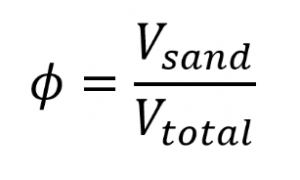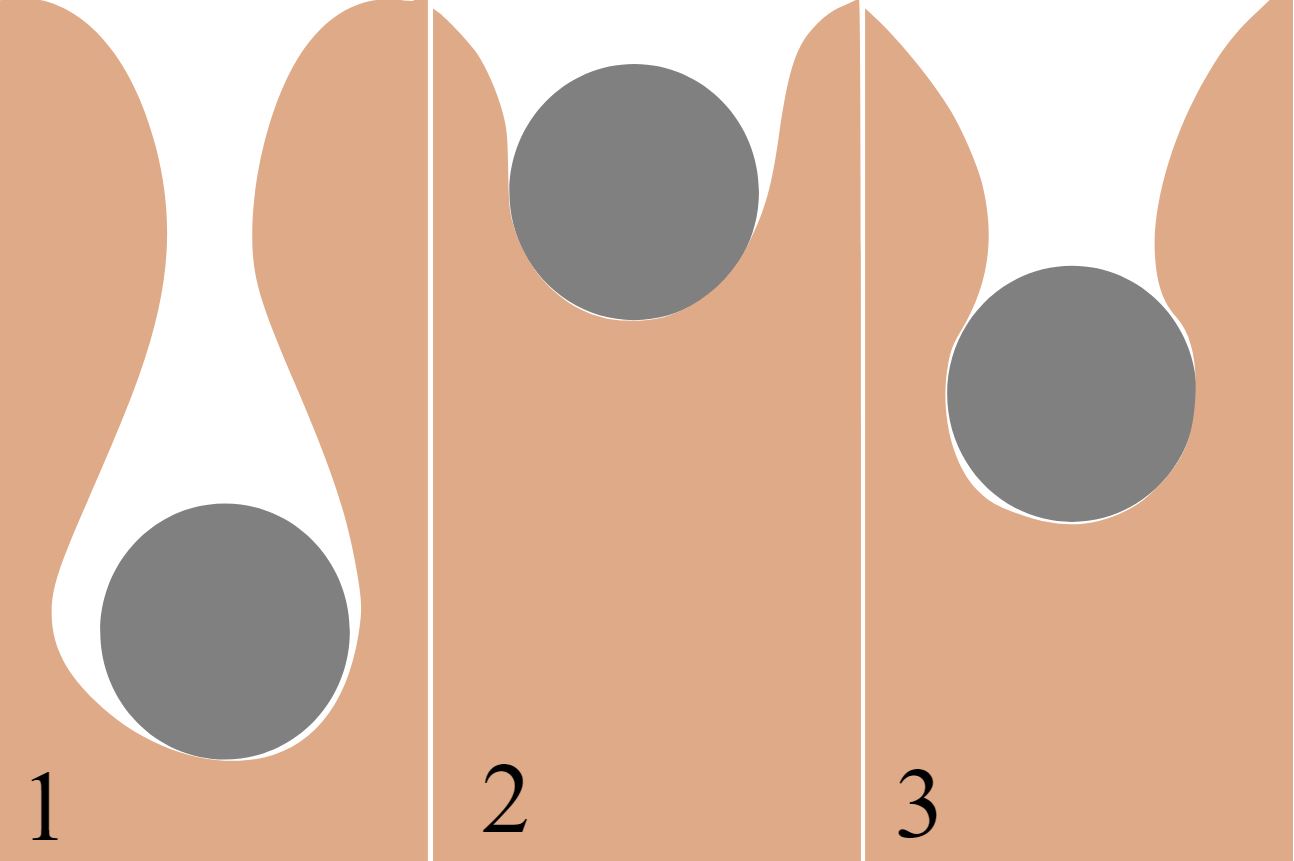What is a fluidized bed?
A fluidized bed is a layer of material in the solid state that is mixed with a fluid, i.e. a gas or a liquid such that the mixture behaves like a fluid. Some of those properties of a liquid are a horizontal surface and sinking of objects with a higher density than the bed.
A fluidized bed is often made with a granular material. It is then also called a granular bed. During this experiment, a granular bed is used. Both terms are used interchangeably all over this website.
Granular materials are a very own class of materials, that have properties like that of solids, liquids and gases, depending on the circumstances.
How to make a granular bed.
In this experiment, the solid is a very fine-grained sand and the fluid is air. A layer of sand is put on a porous plate in a cylinder. In rest, the sand is relatively dense: the grains are close together and there is only a small amount of air present in-between the grains, so the packing fraction of the sand is relatively high. The packing fraction is defined as 
where Φ is the packing fraction, Vsand is the volume of all the sand grains (the solid state) and Vtotal is the total volume of the sand grains and the interstitial air.
Air is blown uniformly through the porous plate, so it travels upward through the sand. The airflow is then slowly reduced to zero. If done correctly, the sand doesn’t go back to its initial state, but some air stays trapped in-between the grains, so the packing fraction is lower. Note that the airflow has to be uniform throughout the cylinder, otherwise the packing fraction differs throughout the cylinder.
Impact on a fluid
When a solid ball hits the surface of a liquid, this impact has some typical effects. The effect studied during this research is the formation of a jet. Jet formation can be described, but it is easier to show the effect.
Why does a jet appear?
As a ball falls through air, the air flows around it. For a ball of 2 centimeters in diameter, this flow is turbulent: a sphere of this size moving in air of 15 °C has a Reynolds number of approximately 1370 at a typical velocity of 1 m/s (for a kinematic viscosity of air of 1.46*10-5 m2/s) and linearly increases with increasing velocity, whereas fully laminar flow occurs only for a Reynolds number below approximately 10 for this situation. Thus, a wake will form behind the ball. Note that the values used are only valid under specific conditions, but since this research is performed in a comparable situation, the Reynolds number will be of the right order of magnitude.
As the ball enters another fluid, the fluid initially flows around the ball and the wake, so the wake remains intact. This results in a cavity, filled with air, connecting the wake to the surface. As the ball progresses into the fluid and the wake progresses with it, the hydrostatic pressure will take over and the cavity will collapse. This effect is named pinching off. When the fluid pinches the cavity off behind the wake, two jets form: one going downward into the wake and the other shooting upward. As the ball slows down, the air in the wake will rise back to the surface.

In the above displayed image, the possible formation of a cavity is displayed under various packing fractions. At 1, the packing fraction is smaller then the critical packing fraction and a cavity is formed. At 2, the packing fraction is higher then the critical fraction and there is no cavity formed. And finally at 3, the packing fraction is equal to the critical value and there is almost a cavity formed.
Impact on a granular bed
When a ball falls into a fluid, a jet is formed and the surface smoothens out after some time. When a ball falls into a granular solid, the ball does not penetrate the surface but leaves a crater into the surface.
When a ball falls onto a granular bed, a combination of the effects of a solid and a liquid is seen. When the bed is not fluidized, the ball leaves a crater on the surface and the ball itself remains on the surface, just like a solid. When the bed is fluidized, the ball penetrates the surface and a jet can be formed, but the surface does not completely smoothen afterwards.
This indicates that a granular bed behaves both like a solid and a like a liquid. As said, the liquid behaviour is only seen under the right conditions: if these are not fulfilled, the bed acts like a solid and the ball lands on the surface, without going in or forming a jet.
In this project, the boundary conditions for which the granular bed exhibits fluid-like behaviour i.e. forms a jet upon impact of a ball are studied. One of these boundary conditions is studied: the effect of the packing fraction on the jet formation. A relationship between the height of the jet and the packing fraction and a relation between the height of the jet and the impact velocity of the ball is studied.
How the jet height depends on the packing fraction
If the ball falls on a bed with a high packing fraction, the ball will penetrate the sand less easily, possibly not even entering at all. On the other hand, if the packing fraction is low, the ball goes through the surface more easily, as the sand is more easily pushed aside. Thus, after an impact on a very dense bed, no jet will form. Up until some critical packing fraction, this continues to be the case. Just below this critical packing fraction, the ball will go in deep enough to create a cavity and a jet will form. If the packing fraction is decreased further, the ball will progress deeper into the bed, the cavity will also collapse at a point deeper in the bed and the jet will go higher. However, the nature of the relation between the packing fraction and the jet height is unknown.
How the jet height depends on the impact velocity
If the ball falls on the bed with a higher velocity, it will mean that the ball will be able to penetrate the bed deeper, resulting in a higher jet. However Katsuragi & Durian (2007) showed that the drag force on a particle in a granular bed is dependent on the square of the velocity of the particle. This means that the jet height will probably increase with increasing impact velocity, but the slope of that line will gradually decrease.